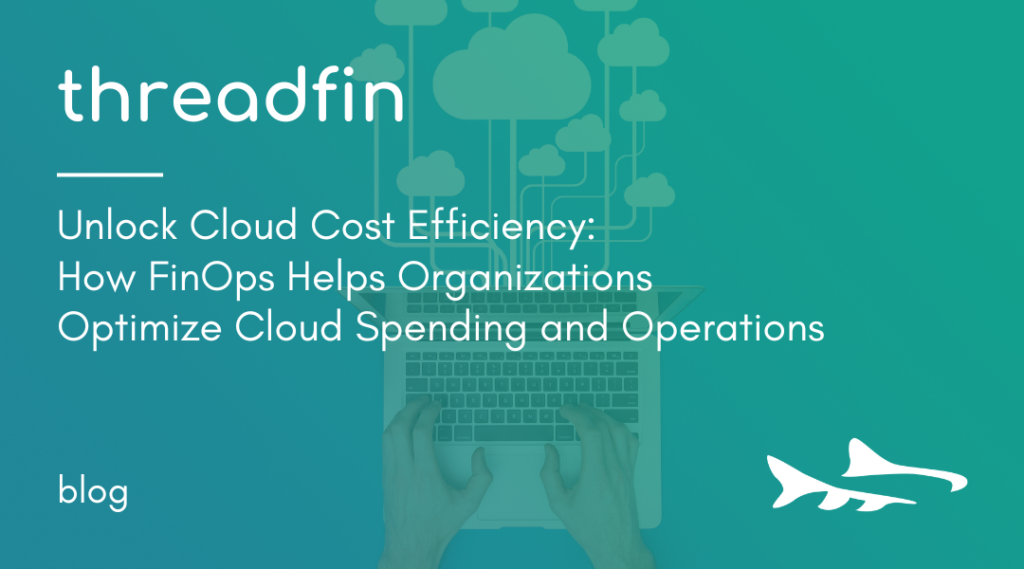Introduction
Many organizations migrate to the cloud as part of their digital transformation journey. Cost reduction is often attributed to cloud computing, but the reality is that moving to the cloud isn’t just about cost-cutting; true value is found in allocating funds wisely. FinOps helps organizations optimize cloud spending and operations. Read on to learn how you can unlock cloud cost efficiency.
Roman Diaz, Threadfin’s Microsoft Practice Lead, says, “From a cost standpoint, you really have to manage a move to the cloud carefully. Server set-up and infrastructure configuration must be right-sized or your costs will hemorrhage out of control. Threadfin has spent a lot of time in this space, making sure we optimize and manage costs so customers aren’t caught off-guard.”
Research suggests that organizations waste close to 32% of their cloud spend. Cloud cost optimization is becoming a top priority, with a focus on adopting practices that are not purely financial or purely technical in nature. Instead, they’re a hybrid of both. FinOps is a collaboration between teams that helps achieve desired business outcomes.
Keep reading as we delve into FinOps, from what it is to the ways it helps achieve cloud cost optimization and increases operational efficiency.
FinOps Explained
FinOps, short for financial operations, is shared financial accountability for the expenses incurred in cloud deployment, operations and related infrastructure. FinOps brings the finance, business and technology teams together to collaboratively share responsibility for the organization’s cloud computing and infrastructure costs.
While organizations might assume that the cloud is synonymous with cost reduction, the reality is very different. Because cloud spending accounts for a substantial share of IT budgets, it’s imperative that enterprises keep tabs on their cloud expenses. We believe that strong FinOps is the best way to do this.
Improved Analysis, Forecasting and Decision-Making
FinOps combines the perspectives of finance and operations using data and financial acumen to optimize operations.
As developers work alongside the finance team to build monitoring or other tools that are technically robust and cost-effective, your organization will be able to more accurately predict future consumption.
FinOps emphasizes forecasting future requirements and preparing in advance. For example, if you’re already aware of a requirement, you can reserve instances in advance at a relatively lower cost than pay-as-you-go rates.
When cloud lifecycle processes are used in conjunction with the forecasting and budgeting expertise of your finance team, it makes for better analysis of expenditure variances which results actionable insight and more informed decisions.
Streamlined Cloud Expenses
Cloud expenses constitute a major chunk of the IT investments at modern organizations, but organizations don’t often segregate cloud components by cost to fully understand the amount allocated toward each element. This can result in serious misuse of funds, causing a loss in investment.
Organizations must take stock of all the different components (file sharing, monitoring, etc.) and review the costs associated with each. For example, if you only consider storage expenses and overlook transfer costs, you’d have real issues. If you leave VMs running when not in use, you’re inviting heavy expenditures. You must rightsize your resources so that only you pay for what you need and use—nothing additional.
FinOps brings awareness to cloud waste and, in turn, optimizes cloud cost.
Shared Financial Accountability
FinOps is also sometimes referred to as cloud financial accountability. It significantly contributes to fostering financial responsibility across organizations. Using diverse strategies to ensure financial accountability with regard to cloud costs helps organizations optimize and achieve cost efficiency.
FinOps also enforces spending visibility across teams, promoting transparency and creating awareness of which teams have optimized their expenses. Building these habits by gamifying optimization goals through dashboards and rewards, can encourage teams to become more engaged and to contribute more toward cloud cost optimization.
Improved Employee and Customer Experience
End-user experience is a priority when it comes to cloud applications. When organizations right-size and optimize cloud infrastructure, employees perform better and customer experience is positively impacted. When you use FinOps to effectively cut the time and resources spent on the cloud, focus can return to crafting hassle-free customer experiences.
Efficiency through Automation
There are huge amounts of data to be handled in an organization and managing it manually via spreadsheet is not the way to go. Instead, organizations should use AI-enabled automation techniques to monitor application performance, detect budget inefficiencies and more. In addition to FinOps, these automation tools can also aid significantly in cloud cost optimization.
Summary
With the ability to boost returns by optimizing cloud and infrastructure costs, FinOps holds tremendous potential. At Threadfin, we use FinOps and Experience Threading to support your organization, employees and customers through financial accountability in optimized cloud, hybrid and on-premises solutions.
Read more about our FinOps solution here and start working with us today.

